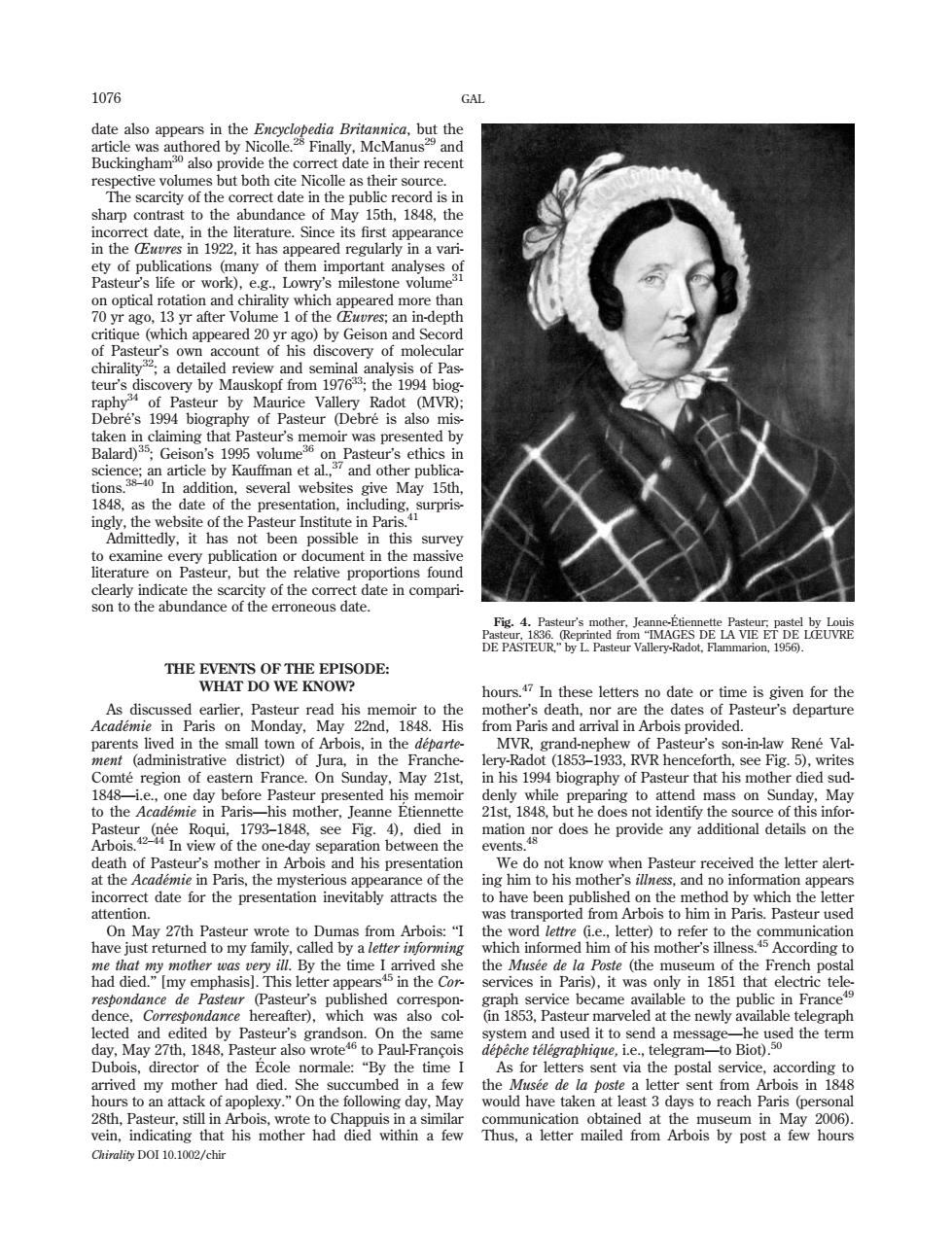正在加载图片...

1076 GAL ect date in ther but both cite sham contrast to the abundance of May 15th I8 in the res in 1922it has ared 2 da o)by Geison and disco Debre's19 biog 1005 as pre othe 1848.as the date of the pr tati including not beer to examine e erroneou 益产意碳 THE EVENTS OF THE EPISODE WHAT DO WE KNOW? ssed earlier,Pasteur read his Paris on Monday 22nd ioufnandammlnAtasmpdc Rene Val en (administrative district)of Jura.in the Fran Fig to the Acc anne on nor of the one earance of the the nevitably attracts the to h On May 27th Pasteur wrote to Dum as I rom Arbois:" r)to refer that my mother was By the time i ed she the Musee de la Poste (the muse 5 ter ap the Co blished c in Paris),it in tele hereafter). hich also col (n 1853.Pasteur marveled at the egraph iay, eur also wrote o PaulFrancois the or le sent v the to an atta plexy." On the follow g day would hav e taken lays to reach .pe2006 vein.indicating that his mother had died within a few Chirality DOI 10.1002/chir date also appears in the Encyclopedia Britannica, but the article was authored by Nicolle.28 Finally, McManus29 and Buckingham30 also provide the correct date in their recent respective volumes but both cite Nicolle as their source. The scarcity of the correct date in the public record is in sharp contrast to the abundance of May 15th, 1848, the incorrect date, in the literature. Since its first appearance in the Œuvres in 1922, it has appeared regularly in a variety of publications (many of them important analyses of Pasteur’s life or work), e.g., Lowry’s milestone volume31 on optical rotation and chirality which appeared more than 70 yr ago, 13 yr after Volume 1 of the Œuvres; an in-depth critique (which appeared 20 yr ago) by Geison and Secord of Pasteur’s own account of his discovery of molecular chirality32; a detailed review and seminal analysis of Pasteur’s discovery by Mauskopf from 197633; the 1994 biography34 of Pasteur by Maurice Vallery Radot (MVR); Debre´ ’s 1994 biography of Pasteur (Debre´ is also mistaken in claiming that Pasteur’s memoir was presented by Balard)35; Geison’s 1995 volume36 on Pasteur’s ethics in science; an article by Kauffman et al.,37 and other publications.38–40 In addition, several websites give May 15th, 1848, as the date of the presentation, including, surprisingly, the website of the Pasteur Institute in Paris.41 Admittedly, it has not been possible in this survey to examine every publication or document in the massive literature on Pasteur, but the relative proportions found clearly indicate the scarcity of the correct date in comparison to the abundance of the erroneous date. THE EVENTS OF THE EPISODE: WHAT DO WE KNOW? As discussed earlier, Pasteur read his memoir to the Acade´mie in Paris on Monday, May 22nd, 1848. His parents lived in the small town of Arbois, in the de´partement (administrative district) of Jura, in the FrancheComte´ region of eastern France. On Sunday, May 21st, 1848—i.e., one day before Pasteur presented his memoir to the Acade´mie in Paris—his mother, Jeanne E´ tiennette Pasteur (ne´ e Roqui, 1793–1848, see Fig. 4), died in Arbois.42–44 In view of the one-day separation between the death of Pasteur’s mother in Arbois and his presentation at the Acade´mie in Paris, the mysterious appearance of the incorrect date for the presentation inevitably attracts the attention. On May 27th Pasteur wrote to Dumas from Arbois: ‘‘I have just returned to my family, called by a letter informing me that my mother was very ill. By the time I arrived she had died.’’ [my emphasis]. This letter appears45 in the Correspondance de Pasteur (Pasteur’s published correspondence, Correspondance hereafter), which was also collected and edited by Pasteur’s grandson. On the same day, May 27th, 1848, Pasteur also wrote46 to Paul-Franc¸ois Dubois, director of the E´ cole normale: ‘‘By the time I arrived my mother had died. She succumbed in a few hours to an attack of apoplexy.’’ On the following day, May 28th, Pasteur, still in Arbois, wrote to Chappuis in a similar vein, indicating that his mother had died within a few hours.47 In these letters no date or time is given for the mother’s death, nor are the dates of Pasteur’s departure from Paris and arrival in Arbois provided. MVR, grand-nephew of Pasteur’s son-in-law Rene´ Vallery-Radot (1853–1933, RVR henceforth, see Fig. 5), writes in his 1994 biography of Pasteur that his mother died suddenly while preparing to attend mass on Sunday, May 21st, 1848, but he does not identify the source of this information nor does he provide any additional details on the events.48 We do not know when Pasteur received the letter alerting him to his mother’s illness, and no information appears to have been published on the method by which the letter was transported from Arbois to him in Paris. Pasteur used the word lettre (i.e., letter) to refer to the communication which informed him of his mother’s illness.45 According to the Muse´e de la Poste (the museum of the French postal services in Paris), it was only in 1851 that electric telegraph service became available to the public in France49 (in 1853, Pasteur marveled at the newly available telegraph system and used it to send a message—he used the term de´peˆche te´le´graphique, i.e., telegram—to Biot).50 As for letters sent via the postal service, according to the Muse´e de la poste a letter sent from Arbois in 1848 would have taken at least 3 days to reach Paris (personal communication obtained at the museum in May 2006). Thus, a letter mailed from Arbois by post a few hours Fig. 4. Pasteur’s mother, Jeanne-E´ tiennette Pasteur; pastel by Louis Pasteur, 1836. (Reprinted from ‘‘IMAGES DE LA VIE ET DE LŒUVRE DE PASTEUR,’’ by L. Pasteur Vallery-Radot, Flammarion, 1956). 1076 GAL Chirality DOI 10.1002/chir